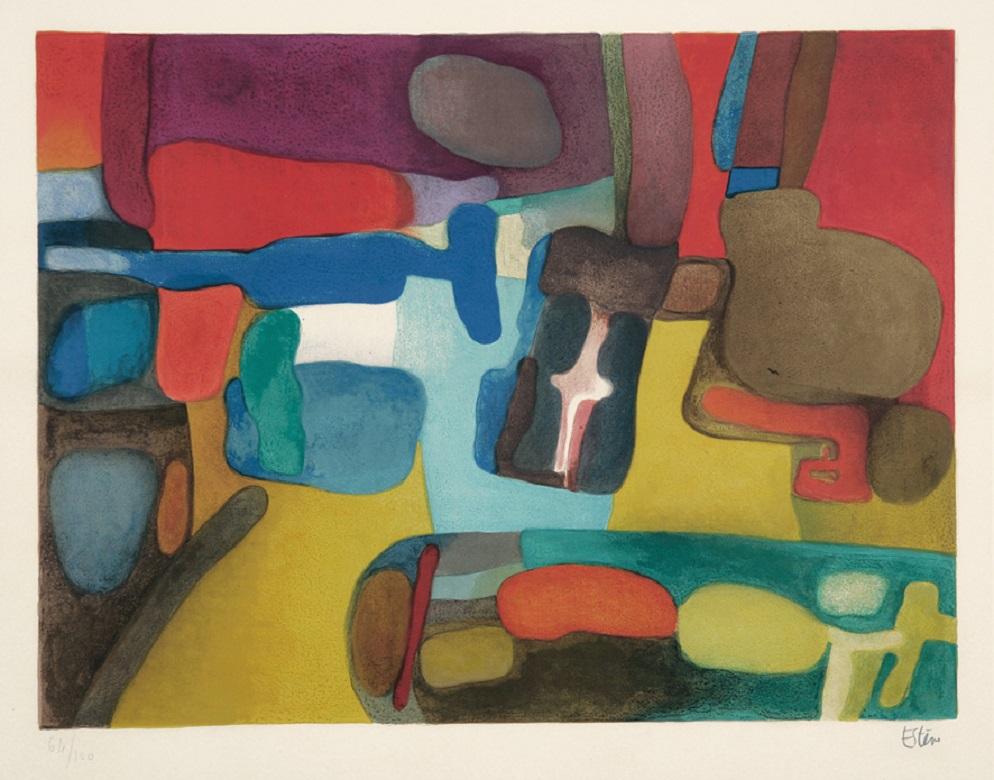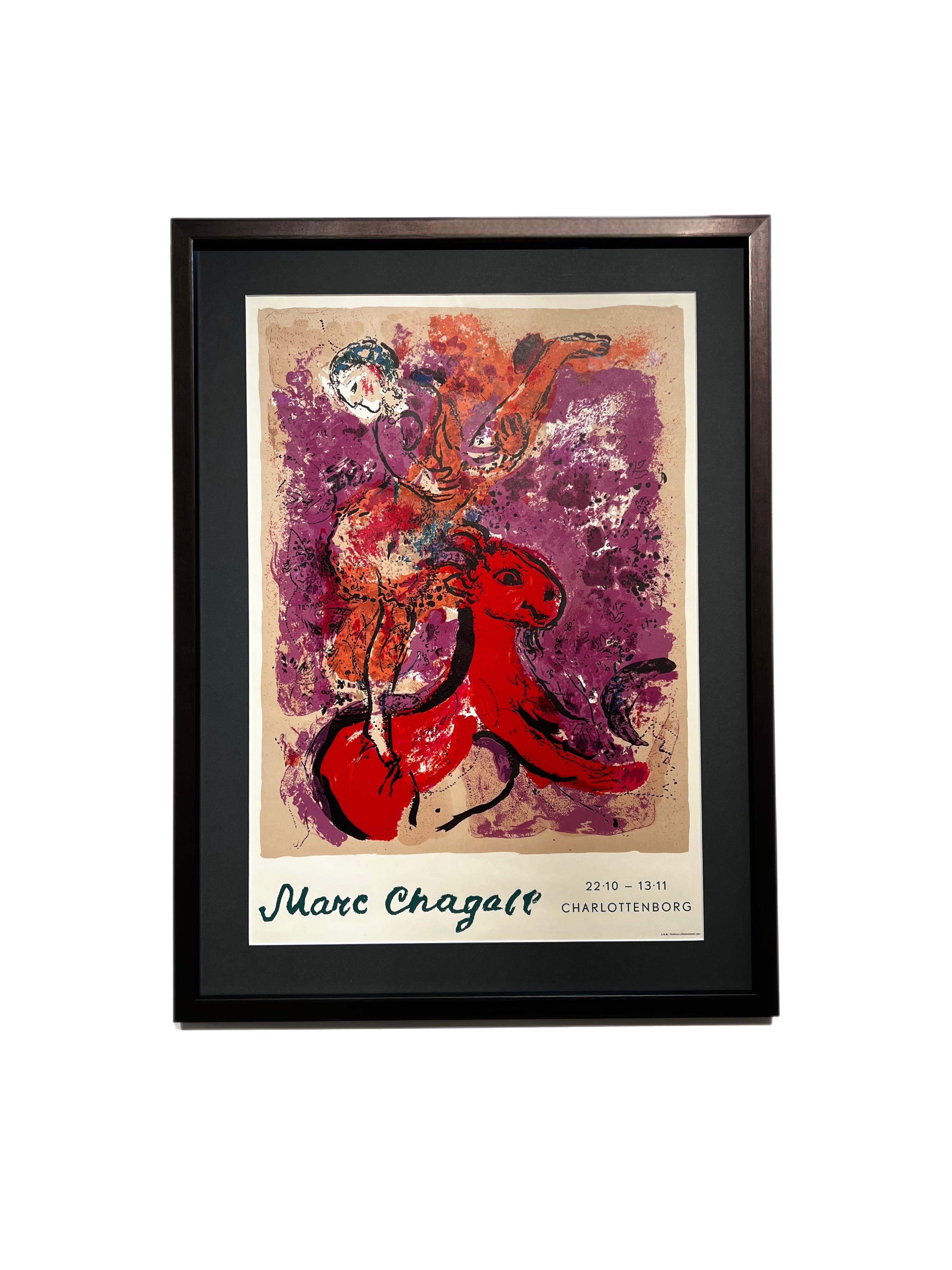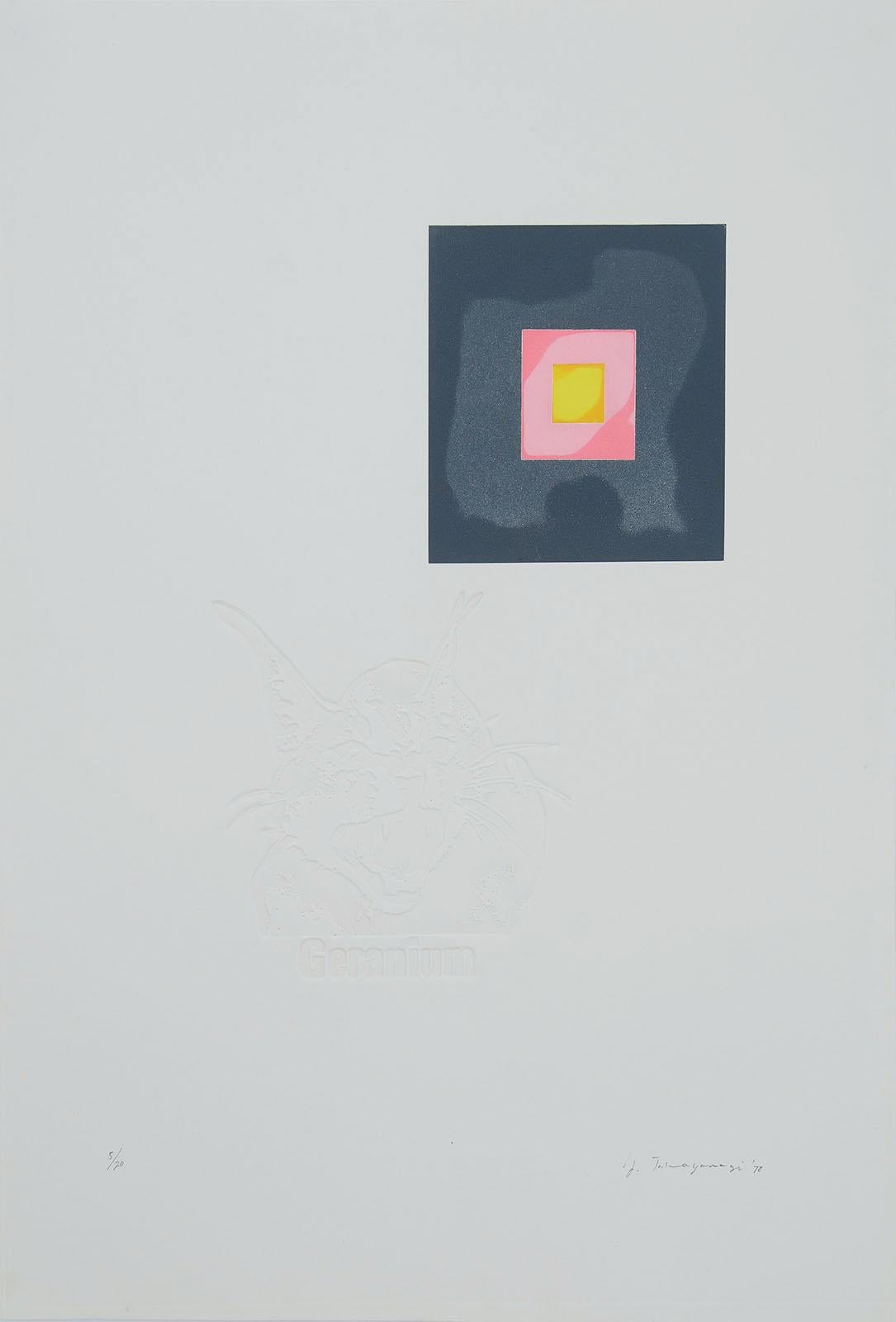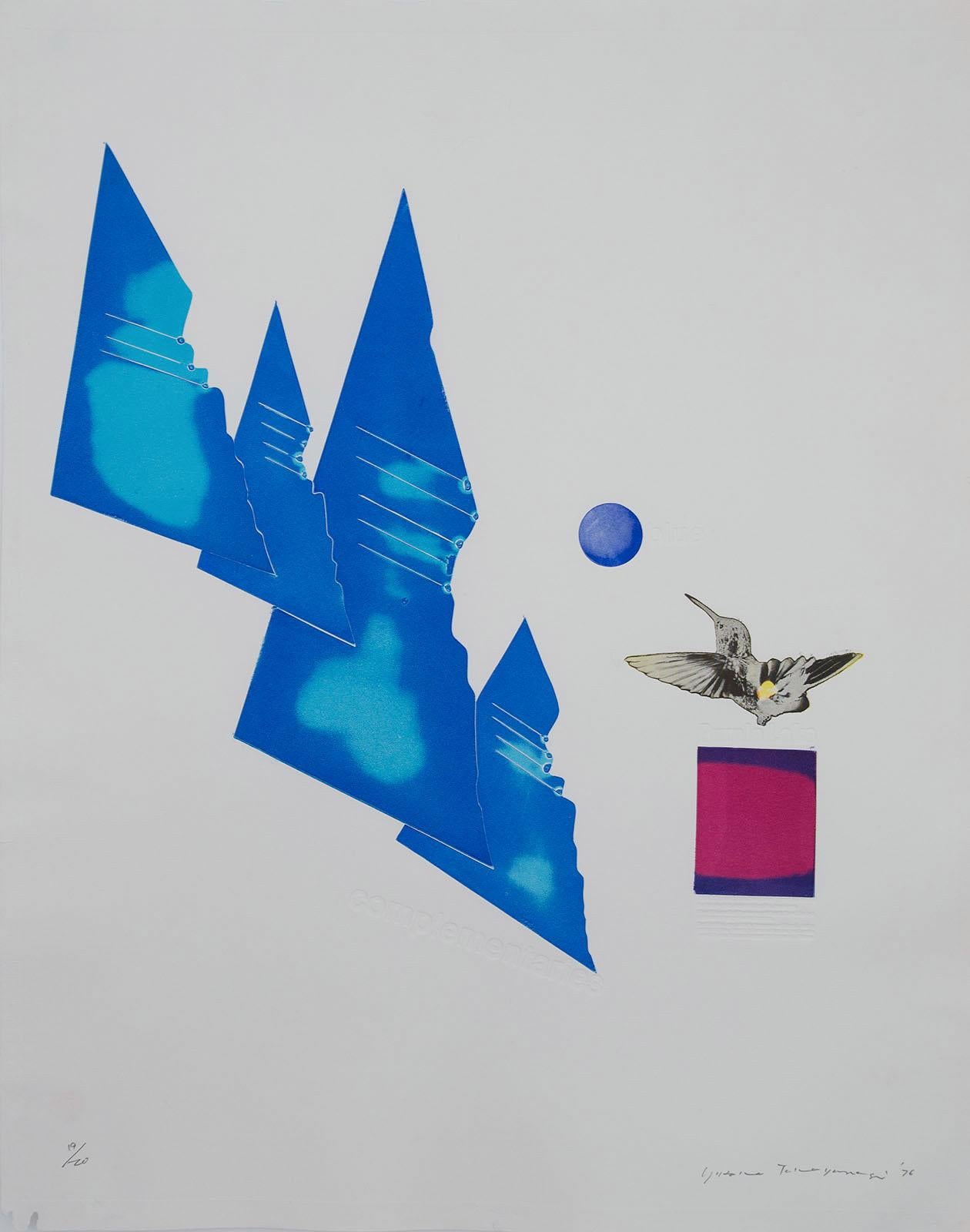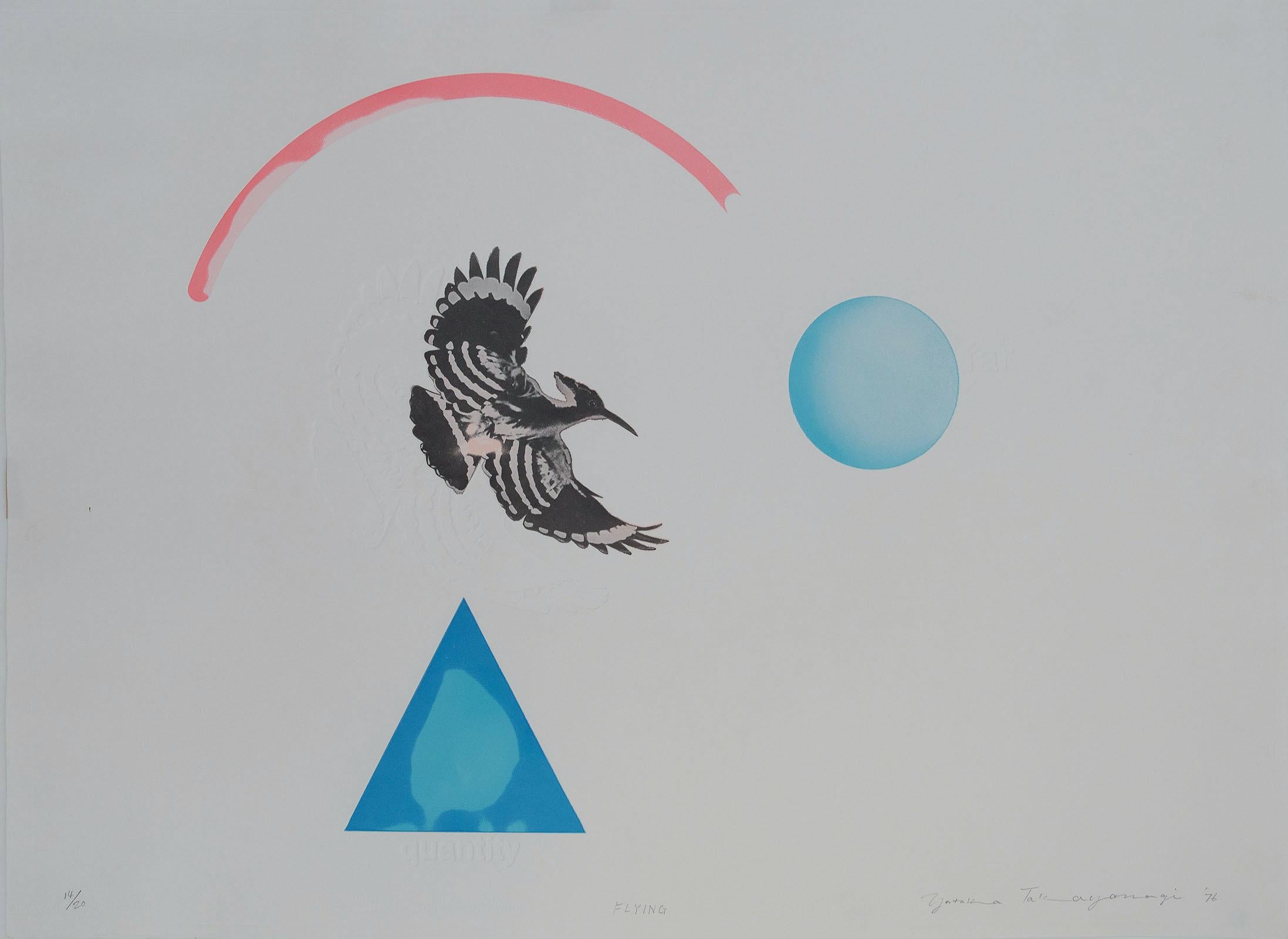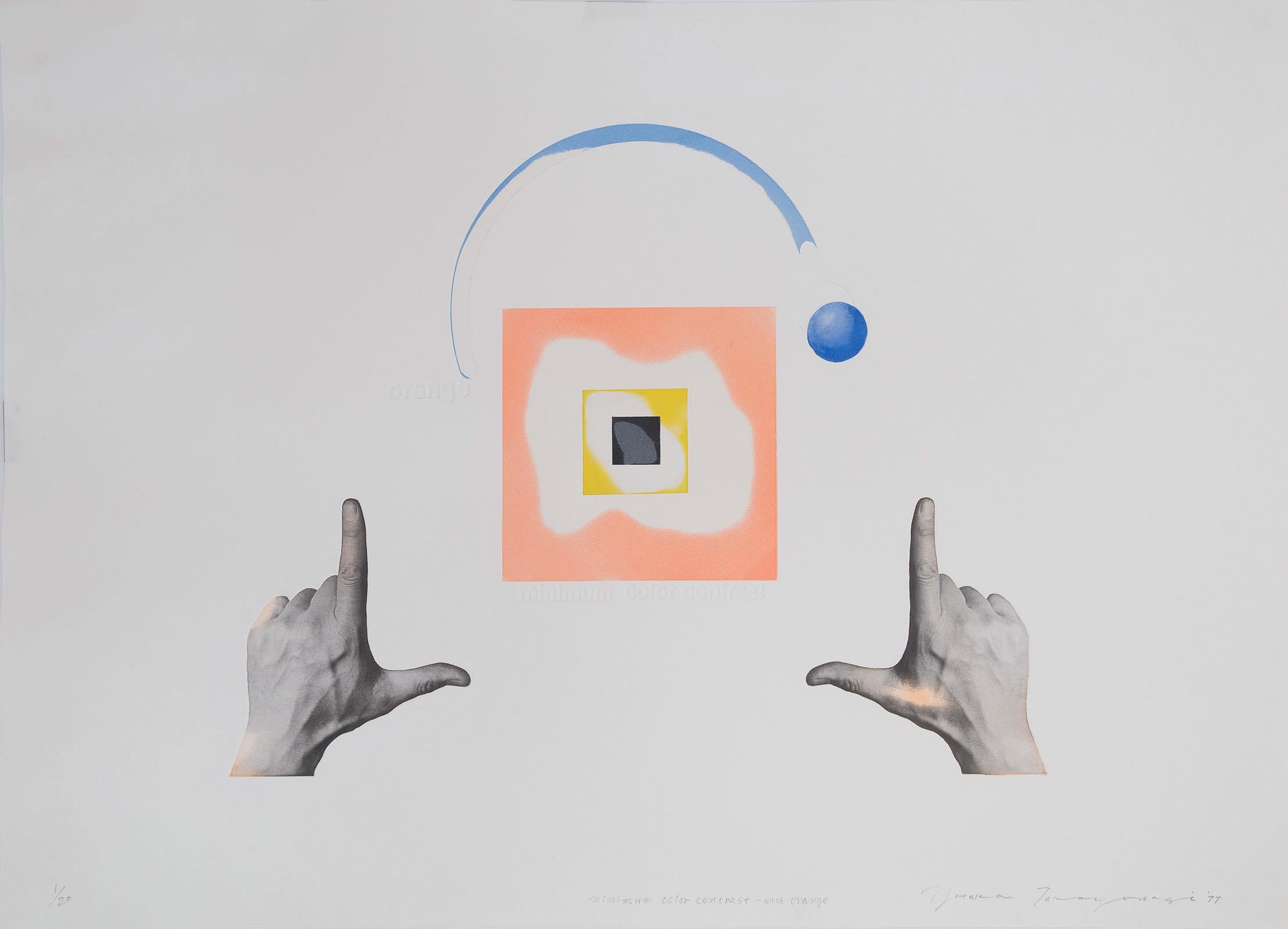Joan MiróFoldout from catalogue for 'Terres de grand feu' lithograph by Joan Miró1956
1956
About the Item
- Creator:Joan Miró (1893 - 1983, Catalan)
- Creation Year:1956
- Dimensions:Height: 19 in (48.26 cm)Width: 38.25 in (97.16 cm)
- Medium:
- Movement & Style:
- Period:
- Condition:Overall excellent condition; vertical creases original to print.
- Gallery Location:Milwaukee, WI
- Reference Number:
Joan Miró
With his wide-ranging oeuvre, comprising strikingly original paintings, prints, ceramics, sculptures, metal engravings and murals, Catalan modernist Joan Miró was a critical force in moving 20th-century art toward complete abstraction. Although often considered an early Surrealist because of his nonobjective imagery and evocation of the subconscious, he defies neat categorization.
Miró’s identity is largely rooted in the city of his birth: Barcelona. To this day, a number of his public artworks can be found there, including the 72-foot-tall statue Dona i Ocell (Woman and Bird), 1983. Female and avian forms, along with bright colors and the theme of Catalan pride, are recurring elements in his work.
The radical visual world Miró created with his expressive lines, signature symbols and biomorphic shapes influenced such American Abstract Expressionists as Jackson Pollock and Color Field painters like Mark Rothko and Barnett Newman.
Mirò continued to work and experiment until his death at the age of 90 in 1983. Five years before that, he was quoted saying, “I painted these paintings in a frenzy, with real violence so that people will know that I am alive, that I’m breathing, that I still have a few more places to go. I’m heading in new directions.”
Find a collection of original Joan Miró art on 1stDibs.
- ShippingRetrieving quote...Ships From: Milwaukee, WI
- Return PolicyThis item cannot be returned.
- Original Lithograph VI, from Miro Lithographs II, Maeght Publisher by Joan MiróBy Joan MiróLocated in Milwaukee, WI"Original Lithograph VI" is an original color lithograph by Joan Miro, published in "Miro Lithographs II, Maeght Publisher" in 1975. It depicts Miro's signature biomorphic abstract s...Category
1970s Abstract Abstract Prints
MaterialsLithograph
- Original Lithograph V, from Miro Lithographs III, Maeght Publisher by Joan MiróBy Joan MiróLocated in Milwaukee, WI"Original Lithograph V" is an original color lithograph by Joan Miro, published in "Miro Lithographs III, Maeght Publisher" in 1977. It depicts Mir...Category
1970s Abstract Abstract Prints
MaterialsLithograph
- "Fast Feast, " an Abstract Geometrical Lithograph signed by James RosenquistBy James RosenquistLocated in Milwaukee, WIA multicolored abstract lithograph by American artist James Rosenquist. This is number 36 from the edition of 100. Signed and dated lower right. Numbered and titled lower left. 37" ...Category
1970s Abstract Abstract Prints
MaterialsLithograph
- "Graceful Touch, " original lithograph signed abstract floral peaceful vibrantBy Michael KniginLocated in Milwaukee, WI"Graceful Touch" is an original color lithograph by Michael Knigin. The artist signed the piece in the lower center, and wrote the title and "AP 1" (artist's proof #1). It features a...Category
1980s Abstract Abstract Prints
MaterialsLithograph, Ink
- "Untitled 1970 C.P. #235" original lithograph abstract pop art signed mellowBy Garo Zareh AntreasianLocated in Milwaukee, WI"Untitled 1970 C.P. #235" is an original color lithograph with blended ink signed by the artist Garo Zareh Antreasian. It is editioned 10/60 in the center lower left margin with grap...Category
1970s Abstract Geometric Abstract Prints
MaterialsInk, Lithograph
- "Light on Water" Original Color Lithograph signed on verso by Emmi WhitehorseBy Emmi WhitehorseLocated in Milwaukee, WI"Light on Water" is an original 13 color lithograph with pochoir from 4 aluminum plates and 1 mylar stencil. It was created by the artist Emmi Whitehors...Category
Early 2000s Abstract Abstract Prints
MaterialsLithograph, Stencil
- Cali - 20th Century, Maurice Estève, Abstract Print, Colourful, LithographBy Maurice EstèveLocated in Köln, DE"Cali" is a typical motif by Maurice Estève. The lithograph in colours was published in an edition of 100. 49,6 x 65 cm. Signed and numbered.Category
1960s Abstract Abstract Prints
MaterialsLithograph
- Woman Circus Rider on Red Horse - superb Chagall posterBy Marc ChagallLocated in London, GBOriginal lithographic poster printed by L.R.B Permild and Rosengreen.Category
Late 20th Century Abstract Abstract Prints
MaterialsLithograph
- GeraniumLocated in Llanbrynmair, GB’Geranium’ By Yutaka Takayanagi. Medium - Relief and lithographic print Edition - 5/20 Signed - Yes Size - 510mm x 660mm Date - 1978 Condition - Excellent. 10 out of 10. Born in Tokyo in 1941, Takayanagi's artistic journey began when he enrolled at Tokyo University of the Arts in 1960, studying under the renowned oil painter Kaoru Yamaguchi. His talent was quickly recognized when he received an Honorable Mention at the 8th Shell Arts Award Exhibition in the same year. During his time at university, Takayanagi took an intensive course in copper plate printing under Tetsuro Komai, receiving his degree from the graduate school in 1966. Fascinated by the simultaneous color print method, he started creating copperplate prints and soon gained recognition for his unique metallic reliefs, which he produced using collages of English newspapers. Takayanagi's passion for experimentation led him to create metallic emboss reliefs using his own photographs, and in the latter half of the 1980s, he moved on to silkscreen prints. He continued to push the boundaries of his art, constantly exploring new techniques and mediums. In 1978 and the following year, Takayanagi was appointed as an arts researcher for the Ministry of Culture and traveled to the United States, France, and the UK. These experiences enriched his artistic perspective and further cemented his reputation as a highly regarded artist. Takayanagi was part of the influential printmaking group Sosaku Hanga, which emerged in the early 20th century in Japan. This movement emphasized the artist's involvement in every stage of the printmaking process, from designing the image to carving and printing the blocks. Takayanagi's work often incorporates elements of nature and landscape, with an emphasis on texture and pattern. He also experimented with collage, incorporating found materials like newspaper clippings and photographs into his prints. Takayanagi's work has been exhibited extensively in Japan and internationally, including at the Museum of Modern Art in New York and the National Museum of Modern Art in Tokyo. He has also received numerous awards for his contributions to printmaking, including the Japan Print Association Award and the Purple Ribbon Medal...Category
1970s Abstract Abstract Prints
MaterialsLithograph
- ComplementariesLocated in Llanbrynmair, GB’Complementaries’ By Yutaka Takayanagi. Medium - Relief and lithographic print Edition - 19/20 Signed - Yes Size - 615mm x 780mm Date - 1976 Condition - Good. 9 out of 10. Born in Tokyo in 1941, Takayanagi's artistic journey began when he enrolled at Tokyo University of the Arts in 1960, studying under the renowned oil painter Kaoru Yamaguchi. His talent was quickly recognized when he received an Honorable Mention at the 8th Shell Arts Award Exhibition in the same year. During his time at university, Takayanagi took an intensive course in copper plate printing under Tetsuro Komai, receiving his degree from the graduate school in 1966. Fascinated by the simultaneous color print method, he started creating copperplate prints and soon gained recognition for his unique metallic reliefs, which he produced using collages of English newspapers. Takayanagi's passion for experimentation led him to create metallic emboss reliefs using his own photographs, and in the latter half of the 1980s, he moved on to silkscreen prints. He continued to push the boundaries of his art, constantly exploring new techniques and mediums. In 1978 and the following year, Takayanagi was appointed as an arts researcher for the Ministry of Culture and traveled to the United States, France, and the UK. These experiences enriched his artistic perspective and further cemented his reputation as a highly regarded artist. Takayanagi was part of the influential printmaking group Sosaku Hanga, which emerged in the early 20th century in Japan. This movement emphasized the artist's involvement in every stage of the printmaking process, from designing the image to carving and printing the blocks. Takayanagi's work often incorporates elements of nature and landscape, with an emphasis on texture and pattern. He also experimented with collage, incorporating found materials like newspaper clippings and photographs into his prints. Takayanagi's work has been exhibited extensively in Japan and internationally, including at the Museum of Modern Art in New York and the National Museum of Modern Art in Tokyo. He has also received numerous awards for his contributions to printmaking, including the Japan Print Association Award and the Purple Ribbon Medal...Category
1970s Abstract Abstract Prints
MaterialsLithograph
- FlyingLocated in Llanbrynmair, GB’Flying’ By Yutaka Takayanagi. Medium - Relief and lithographic print Edition - 14/20 Signed - Yes Size - 790mm x 570mm Date - 1976 Condition - Excellent. 10 out of 10. Born in Tokyo in 1941, Takayanagi's artistic journey began when he enrolled at Tokyo University of the Arts in 1960, studying under the renowned oil painter Kaoru Yamaguchi. His talent was quickly recognized when he received an Honorable Mention at the 8th Shell Arts Award Exhibition in the same year. During his time at university, Takayanagi took an intensive course in copper plate printing under Tetsuro Komai, receiving his degree from the graduate school in 1966. Fascinated by the simultaneous color print method, he started creating copperplate prints and soon gained recognition for his unique metallic reliefs, which he produced using collages of English newspapers. Takayanagi's passion for experimentation led him to create metallic emboss reliefs using his own photographs, and in the latter half of the 1980s, he moved on to silkscreen prints. He continued to push the boundaries of his art, constantly exploring new techniques and mediums. In 1978 and the following year, Takayanagi was appointed as an arts researcher for the Ministry of Culture and traveled to the United States, France, and the UK. These experiences enriched his artistic perspective and further cemented his reputation as a highly regarded artist. Takayanagi was part of the influential printmaking group Sosaku Hanga, which emerged in the early 20th century in Japan. This movement emphasized the artist's involvement in every stage of the printmaking process, from designing the image to carving and printing the blocks. Takayanagi's work often incorporates elements of nature and landscape, with an emphasis on texture and pattern. He also experimented with collage, incorporating found materials like newspaper clippings and photographs into his prints. Takayanagi's work has been exhibited extensively in Japan and internationally, including at the Museum of Modern Art in New York and the National Museum of Modern Art in Tokyo. He has also received numerous awards for his contributions to printmaking, including the Japan Print Association Award and the Purple Ribbon Medal...Category
1970s Abstract Abstract Prints
MaterialsLithograph
- Minimum colour contrast with orangeLocated in Llanbrynmair, GB’Minimum colour contrast with orange’ By Yutaka Takayanagi. Medium - Relief and lithographic print Edition - 1/20 Signed - Yes Size - 790mm x 570mm Date -1977 Condition - Excellent. 10 out of 10. Born in Tokyo in 1941, Takayanagi's artistic journey began when he enrolled at Tokyo University of the Arts in 1960, studying under the renowned oil painter Kaoru Yamaguchi. His talent was quickly recognized when he received an Honorable Mention at the 8th Shell Arts Award Exhibition in the same year. During his time at university, Takayanagi took an intensive course in copper plate printing under Tetsuro Komai, receiving his degree from the graduate school in 1966. Fascinated by the simultaneous color print method, he started creating copperplate prints and soon gained recognition for his unique metallic reliefs, which he produced using collages of English newspapers. Takayanagi's passion for experimentation led him to create metallic emboss reliefs using his own photographs, and in the latter half of the 1980s, he moved on to silkscreen prints. He continued to push the boundaries of his art, constantly exploring new techniques and mediums. In 1978 and the following year, Takayanagi was appointed as an arts researcher for the Ministry of Culture and traveled to the United States, France, and the UK. These experiences enriched his artistic perspective and further cemented his reputation as a highly regarded artist. Takayanagi was part of the influential printmaking group Sosaku Hanga, which emerged in the early 20th century in Japan. This movement emphasized the artist's involvement in every stage of the printmaking process, from designing the image to carving and printing the blocks. Takayanagi's work often incorporates elements of nature and landscape, with an emphasis on texture and pattern. He also experimented with collage, incorporating found materials like newspaper clippings and photographs into his prints. Takayanagi's work has been exhibited extensively in Japan and internationally, including at the Museum of Modern Art in New York and the National Museum of Modern Art in Tokyo. He has also received numerous awards for his contributions to printmaking, including the Japan Print Association Award and the Purple Ribbon Medal...Category
1970s Abstract Abstract Prints
MaterialsLithograph
